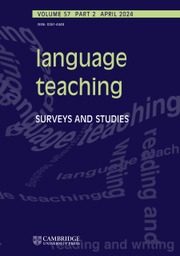Article contents
Corpora in language teaching and learning
Published online by Cambridge University Press: 14 September 2017
Extract
This timeline looks at explicit uses of corpora in foreign or second language (L2) teaching and learning, i.e. what happens when end-users explore corpus data, whether directly via concordancers or integrated into CALL programs, or indirectly with prepared printed materials. The underlying rationale is that such contact provides the massive contextualised exposure needed for language learning, but in a more controlled way than purely haphazard exposure via regular reading or listening, thus promoting or enhancing noticing, language awareness, autonomy, and ultimately producing ‘better learners’. It interweaves with many other notions in language teaching, from authenticity and autonomy to induction and constructivism, taking in much of what we know about language from corpus linguistics itself – its fuzzy, probabilistic nature and the importance of lexical patterns, collocations, chunks, frequencies and distributions. Commonly known as data-driven learning or DDL (Johns 1990), the approach goes back several decades; yet despite its impressive pedigree, a frequent lament is that it remains a marginal practice. Teachers may not be aware of DDL if it is absent from their initial training, or may see it as a research activity confined to higher education. While corpus consultation may appear too demanding for school-age learners, there are connections with the web searches that are already a frequent practice for many. Though lack of uptake is sometimes attributed at least in part to a dearth of empirical research, this claim is increasingly difficult to defend, as witnessed by the number of entries in this timeline and the hundreds of others not included. For a balanced discussion of the limits of DDL as well as what it can reasonably achieve, see Kaltenböck & Mehlmauer-Larcher (2005).
- Type
- Research Timeline
- Information
- Copyright
- Copyright © Cambridge University Press 2017
References
1 Kaltenböck, G. & Mehlmauer-Larcher, B. (2005). Computer corpora and the language classroom: On the potential and limitations of computer corpora in language teaching. ReCALL 17.1, 65–84 Google Scholar.
- 58
- Cited by


